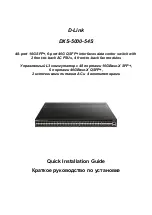
THOR-SSM
24
Rev. : 02/09/2012
2.7 How to Use This Guide
This guide describes the installation and configuration of the THOR Small Switch. Although
the connection and operation of the system is relatively straightforward, you should consider
the following before getting started:
Connection & Compatibility
The individual THOR Small Switch components consist of:
•
THOR Small Switch for CATx: includes the device and power supply.
•
THOR KVM/ Media Local Unit: includes the device, power supply and all the cables
required to connect the THOR KVM/ Media Local Unit to your CPU/ Signal source.
•
THOR KVM/ Media Remote Unit: includes the device and power supply
Please see also
Package Contents
(Page 25).
For information about connection and installation, see page 28.
DDC Information
Normally it is not necessary to make any adjustments to the DVXi- Extender. However, in
some circumstances, it may be necessary to redefine the source of DDC Information for the
CPU. By default, the DVXi/ET KVM-Extender uses its own internal DDC table. If this
setting does not satisfy your requirements, the DDC table can either be switched to the locally
attached screen or could be downloaded from a remotely located screen and stored in the
internal DDC table.
To modify the DDC-Setup, see
DDC / color depth
(page 62).
Selecting the moment of switching to the next frame
The transmission of screen data in not synchronous to the screen change of the graphic card.
Normally, the transmission is terminated during displaying a frame on the screen. If the
device switches to the new frame during the displaying period of the old frame (somewhere
on the screen), it’s possible that you can see horizontal screen breaks in the moment of
switching (default). On the other hand the device must idle until the actual frame is displayed
completely (until VSYNC) -> the number of frames per second transmitted sync.
Selection of Color reduction for transfer speed
You can select whether 24 Bit colors (=full color depth) are always transmitted or whether the
compression algorithm automatically switches between 16 and 24 Bit colors to accelerate the
data transfer (default). Normally the difference between 24 Bit and 16 Bit is not recognizable
but under some special circumstances e.g. in photo processing installations there might be
disturbing color aberrations. However, the automatic color switching enhances the count of
frames transmitted per second; fixed 24 Bit color depth gives smooth color grades under all
circumstances. Please select the best mode for you. To modify the color depth, see
DDC/
color depth
(page 62).
















































